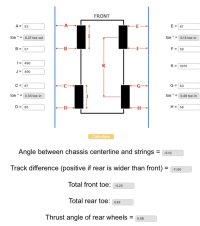Oops, I thought it was the fully loaded setting to simulate the van being low due to the weight?
It’s easy to think that, but it’s not the case. This is copied from a post of mine on another thread, trying to explain why the no load settings should usually be used. It talks more about the rear as it’s the rear that was being discussed at the time…..
The different load settings are to allow an alignment to be done when the van isn’t carrying it’s normal load. When having alignment done, you should ideally arrive with your van carrying whatever load it normally carries, or empty if that’s normal. If you have some weight in there that you wouldn’t normally have, the half load settings might be appropriate. If you are fully loaded, close to, or at the limit of the van, but you wouldn’t normally be, the full load settings are appropriate.
When you have an alignment done using "half" or "full" load, the machine assumes that you are carrying more load than you normally would be, so it assumes that your van is sitting lower than it normally would. The outcome of this is that it adjusts the target "green" tolerance to compensate.
As you lower a T6 and especially on the rear end you will get toe in and negative camber. This is simply because of the geometry of the rear arms and their mounting points.
So, the machine thinks your van is sitting lower than it normally would and adjusts the target numbers to be that for a van sitting higher, it thinks that your wheels don't usually toe in as much as they are and so it doesn't ask the fitter to correct them (as much as it should). It will allow that number to go green when they are still toeing in, assuming that when you get home and take the load out of the van it will sit higher and the toe in will reduce to correct settings. What it doesn't know is that you aren't taking any load out of the van at all, so your suspension geometry doesn't change, the wheels continue to toe in too much and you ruin your rear tyres in no time!
When you have it done with "no load" settings, the machine sets the target numbers assuming that your van runs at it's current ride height and therefore suspension geometry all the time. That means it uses the correct targets for how your van is sitting at the time of the alignment. That gives a toe in target much closer to 0 and makes sure that you get the alignment you need to look after your tyres correctly. This becomes more and more critical the lower your van goes, simply because the lower you go, the further the wheels will toe in until there is no adjustment left.
At some good places, it wouldn’t matter what the target tolerances are, because they will get as close to the centre of the target as possible. The problem is really when a lazy worker will make enough adjustment just to get the result green as quickly as possible, rather than aiming for the centre. On full load settings that can leave you a long way from optimum, but he doesn’t care because he can go back to watching football on his phone.




